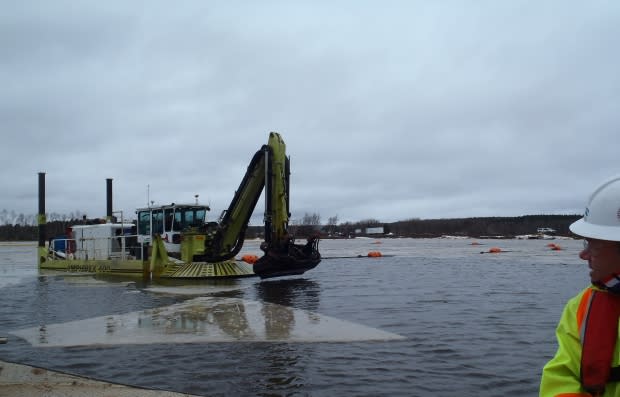Ottawa announces $100M for Boat Harbour cleanup
The federal government is pitching in $100 million to help clean up Boat Harbour, the largest environmentally contaminated site in Nova Scotia.
Central Nova MP Sean Fraser made the announcement Thursday at Pictou Landing First Nation, which is adjacent to the lagoons that have received wastewater effluent from the nearby pulp mill.
Boat Harbour started receiving the wastewater from the mill in 1967. It was sealed off from the Northumberland Strait in 1972.
"Prior to its use as an effluent treatment facility, Boat Harbour was a saltwater habitat used for recreation, food and shelter," said Fraser, as roughly 60 members of the community looked on outside the Pictou Landing Health Centre.
"It's a place where they gathered ceremonial and medicinal herbs for thousands of years."
The Boat Harbour Act was passed in 2015 by Nova Scotia's Liberal government and requires the current effluent treatment facility to close by January 31, 2020.
The move came after pressure from Pictou Landing First Nation, following decades of concerns over the contaminants which include zinc, cadmium and mercury.
Boat Harbour contains 50 years worth of toxic waste, and it has been called one of the worst cases of environmental racism in Canada.
Pictou Landing First Nation Chief Andrea Paul became emotional as she acknowledged the many people who have worked tirelessly over the past five decades to get the estuary cleaned up.
"I remember saying, 'I know this isn't going to be done in my lifetime, but I hope it's going to be done in my grandchildren's lifetime,' and look where we are," said Paul, flanked by children, elders and other members of the community.
"Having Boat Harbour restored to its natural state is all we've ever wanted."
Paul explained that the Mi'kmaq word for the estuary is "a'se'k," which means "the other room."
"It was the common area. It was an extension of their house," she said.
"I just couldn't imagine when they went to this place and it was just gone. Within a few days, everything was taken away from them. It's devastating."
The project will restore the natural flow of water between the ocean and the harbour.

Contaminated soil and sediment will be removed, and improvements will be made to portions of Highway 348, including the construction of a bridge to replace the current causeway.
The Boat Harbour treatment facility is owned by the provincial government, which is on the hook for the cleanup once the facility closes.
The project is expected to cost around $217 million, and will take at least four years to complete.
The province has said the cleanup cannot begin until wastewater stops flowing into the harbour, and the cleanup isn't expected to start until 2021.
As the Boat Harbour Act deadline looms, questions remain about how Northern Pulp will treat its effluent going forward.
In March, Nova Scotia Environment Minister Margaret Miller ruled the company's environment assessment of its proposed new effluent treatment plant did not provide enough information for her to make a decision on the project.
At the time, the CEO of Paper Excellence, the mill's current owners, said the delay meant it would take at least until the summer of 2021 to complete construction work.
The company has repeatedly called for an extension of the Boat Harbour Act, and said without one the mill would be forced to shut down.
But Premier Stephen McNeil has said an extension would not be considered without full community support.
Members of the Pictou Landing First Nation have been unwavering that they do not support an extension.
Northern Pulp did not return a request for comment Thursday.
MORE TOP STORIES

